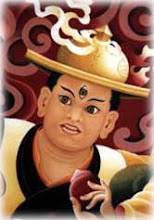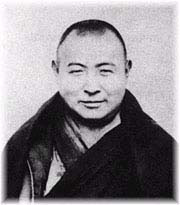Taken from a major Swiss publication Die Weltwoche, with extracts translated from the German. The whole article can be found here:
Die Weltwoche
Die Legenden des Dalai Lama
04.03.2009
The Legends of the Dalai Lama
March 10 this year will see the 50th anniversary of the uprising of the Tibetan people against China. In the West, the spiritual leader, the Dalai Lama, is worshipped like a pop star. Strange. The normally romanticized theocracy was a corrupt feudal system that enslaved its subjects.
By David Signer
Recently, in the context of his most recent trip to Europe, the Dalai Lama could receive the German Media Award in Baden-Baden, which has previously been granted to celebrities such as Nelson Mandela, Bill Clinton or Bono. On March 10 fifty years ago, the Tibetans rose up against the Chinese hegemony. And it is seventy years since a little farmer's boy became 'His Holiness'.
In winter 1937/38 [the common story of recognition follows].
Everybody loves the now 73-year-old Dalai Lama, and in particular have done so since 1998 when Martin Scorsese brought his autobiography called 'Kundun' into our cinemas. From Richard Gere through to Brad Pitt, from Patti Smith through to Peter Maffay, from Dolly Buster to Robbie Williams: everyone worships the non-stop world jet-setting spiritual leader of the Tibetans. When the Dalai Lama came to Switzerland three years ago, during his eight day visit 30,000 people went onto a pilgrimage to the Zurich stadium to see him. And as is clear with the idolization of the Dalai Lama, whom even people who are not normally fond of personality cults, call 'His Holiness', the same is true for Tibet. There is a common agreement that, before the Chinese marched in, this mountainous region was a paradise of meditating monks and happy farmers living in the midst of splendid mountain scenery -- and that it would be again if it were not for the evil occupiers.
The reality is that until fifty years ago Tibet was a clerical-feudal tyranny. The truth is that a lot of the widespread common knowledge about the country is just wishful thinking. There are also dark sides to the biography of the Dalai Lama, and a lot of obscure stuff is mixed in with the esoteric Lamaism Schwärmerei (excessive sentimentality). However, since there is only little journalism on site, it is not easy to find the truth within the jungle of exile Tibetan and Chinese propaganda.
[Now follows some historical background and how the Dalai Lama, once recognized, lived until his escape.]
In the Dalai Lama's autobiography, however, it sounds like paradise when he mentally travels back to the Tibet of his youth: "No one needs to make too much of an effort in order to earn his living. Existence happens on its own and everything works wonderfully." Accordingly, during his reign, he did not make any effort to reform the country, apart from stopping the legal heritage of tax debts. The fact that political decisions are based upon oracles and astrology is no problem for him, who normally pretends to be democratic and progressive. Even though in his 'five point peace plan' he demands 'respect for the democratic freedoms of the Tibetan people', he himself has not tried until today, not even within the exile communities, to be democratically legitimized. Self-evidently he pretends to be the wholistic leader of the Tibetans, even though, strictly speaking, he is not even the spiritual representative of the whole of Tibet. He is merely the head of the Gelugpa order, the so called Yellow Hats, whose claim for leadership he has been trying to pursue for decades. These contradictions are also true for his ecological engagement. On the one hand, he demands to transform Tibet into a kind of natural reserve park and uses every opportunity to demand more ecological thinking in accordance with Mother Nature. On the other hand, from the first days of his exile onwards, at his seat in Dharamsala, the litter keeps being piled up simply on a large waste dump.
[Some stuff on the 1950’s in Tibet.]
While the Dalai Lama and his entourage went into exile to Dharamsala in India, the Cultural Revolution raged in Tibet. Between 1966 and 1976, thousands of monasteries and cultural monuments were destroyed. Switzerland was the first European country which, in 1961, accepted Tibetan refugees and offered them accommodation and work in Rikon. In 1967, the monastic Tibet Institute was opened. The information from the Dalai Lama and Tibet supporters is often not credible with regards to the Chinese occupancy. Very often it is not mentioned that in the meantime approximately half of the monasteries have been restored and are running again. Also, since the mid-nineties, you can no longer claim that there is a ban on the monastic system. If the Dalai Lama is asked about these things he replies that the monasteries have only been rebuilt for the sake of tourists; thus the Chinese are said to have no interest in maintaining the traditional culture but to re-install it as exotic backdrop and in this way it is being doomed even more. One limitation however has been enforced, undoubtedly against the will of the Dalai Lama: no more children can enter the monasteries. Also in his autobiography, 'His Holiness' claims that, due to resettlement programmes, the Chinese proportion of the population overrides the Tibetans. According to the disputed census in 2000, the proportion of Chinese people within the Tibetan Autonomous Region is 6.1%, with the highest proportion, 17%, being in Lhasa. Again and again the claim has been spread that 1.2 million Tibetans had become victims of Chinese terror, in other words a full fifth of the population. Official statements from Dharamsala even sometimes say that all of these have been Tibetan prisoners who were victims of torture or executions, and very often Chinese concentration camps are mentioned. Without doubt, China is far away from regular constitutional affairs; however the charge of systematic, lethal torture of thousands -- as indicated by the term 'concentration camp' -- is hardly plausible.
Esoteric argy bargy
Towards the end of the 1980s there were again riots in Tibet, and in December 1989 the Dalai Lama received the Nobel Peace Price. About one year before that he became friends with the Japanese Shoko Asahara, who ran a 'spiritual community' with several thousand followers near Tokyo. According to the researches of the publisher Colin Goldner, Ashara visited with the Dalai Lama several times in 1988. This community with their 'appreciated aims and activities' (said the Dalai Lama) was 'Aum', one of the most dangerous and totalitarian cults ever, which performed the Tokyo subway poison attacks in March 1995. The Japanese authorities had been patient with the megalomaniac Guru, despite all warnings, possibly due to the protecting hands of the Dalai Lama. When the Centres after the Sarin attack were finally searched, there were deposits of chemical and other weapons which could have killed millions of people at once. The Dalai Lama however could not even find one single word of regret. Even as late as Summer 1995, when at the Peace University in Berlin, he stated that he would recognize Asahara as a 'friend, even though not necessarily an unmistaken one'.
Also the so-called 'Shugden affair' gives rise to doubts about the much-praised wisdom of the Dalai Lama. In Summer 1996, upon the advice of his state oracle, he banned the worship of the protector Deity Dorje Shugden for his people. A number of abbots and monks protested against this ban. They accused the Dalai Lama of violating religious freedom, who reacted to this insubordination by systematic searches of houses and monasteries in the exile community. Shugden statues were destroyed and renitent monks bashed and beaten. Supporter committees even claimed that the Shugden movement was hand in glove with China.
[Mentions the triple murder. More information about that can be found here: Defamatory accusations of murder repeated over and over again for ten years]
Monks armed with iron bars
Generally, the riots before the Olympic Games were presented by the Western media in a way that they fitted into the image of 'peace-loving Tibetans'’ -- either any violence was supposedly coming from the side of the Chinese, or, if not, claims were made to the effect that Tibetan protesters had only acted in self-defence. Footage documentation and reports from eye-witnesses however give evidence of how monks armed with iron bars and bats went marauding through the historic quarter of town. Buses and cars were pushed over and set on fire, and Chinese shops and houses were pillaged. Molotov cocktails were even thrown into kindergartens, schools and hospitals. The Dalai Lama later claimed that the monks had been Chinese soldiers in disguise. This is because, by definition, Tibetans are non-violent. Around the world, demonstrations of solidarity took place.
[The rest is about the Dalai Lama’s right-wing tendencies and the stories about the liaisons between Tibetans and the Nazis and how the Tibetan regent wrote a letter to 'King Hitler'. The final paragraph is on the question why it is that the Dalai Lama is so popular in the West in spite of all the facts mentioned; and the main conclusion is that it is because Westerners are so naive.]





